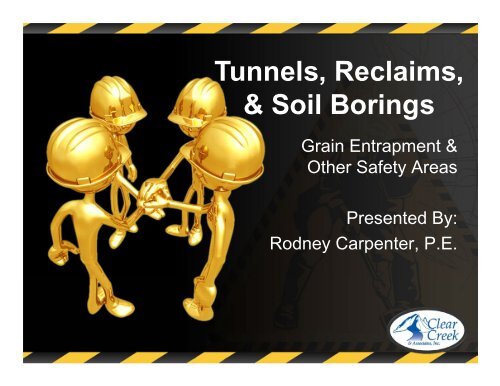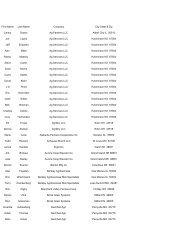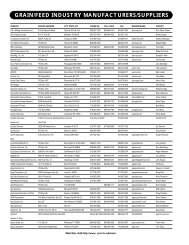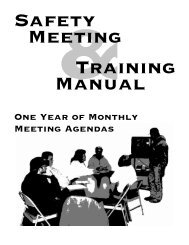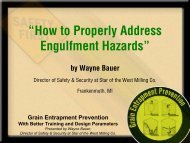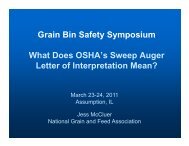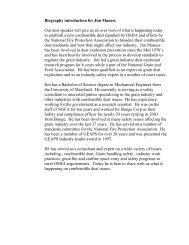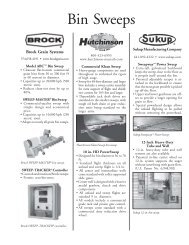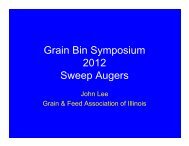Tunnels, Reclaims, & Soil Borings
Tunnels, Reclaims, & Soil Borings
Tunnels, Reclaims, & Soil Borings
Create successful ePaper yourself
Turn your PDF publications into a flip-book with our unique Google optimized e-Paper software.
<strong>Tunnels</strong>, <strong>Reclaims</strong>,<br />
& <strong>Soil</strong> <strong>Borings</strong><br />
Grain Entrapment &<br />
Other Safety Areas<br />
Presented By:<br />
Rodney Carpenter, P.E.
TUNNELS & RECLAIMS<br />
The purpose of reclaims in tunnels is to give better access for<br />
operation, maintenance, & cleaning to both the gates & reclaim<br />
along with protecting the area from the elements
Center Unloading
Unloading Conditions<br />
Clean<br />
Dry<br />
Free Flowing<br />
In Condition
Unloading Not a Simple<br />
Process When:<br />
• Gates plug<br />
• Grain develops clumps<br />
• Foreign items end up in the conveyors<br />
• Grain goes out of condition & becomes<br />
non-free flowing
Off Center Unloading
Grain Facilities Today<br />
• Grain facilities have evolved to a highly<br />
complex operation compared to the past.<br />
Today there is more automation for high<br />
volume incoming & outbound grain.<br />
• The increase has taxed the present state<br />
of practical design. The new direction is to<br />
give a higher level of consideration to<br />
operations, safety, cleanliness, &<br />
maintenance.
History<br />
• Facilities that handled over 2 million<br />
bushels used to be concrete clusters<br />
• Grain bin storage was maxing out at 750k<br />
bushels per bin<br />
• Conveying at 40k bph was high speed<br />
• Filling large dia. bins took days to weeks<br />
• <strong>Soil</strong> loads at 4000psf allowable were great<br />
to build on.
Today<br />
• Facilities can have over 2 million bushels<br />
in 2 corrugated bins<br />
• A single grain bin is capable of storing 1.3<br />
million bushels<br />
• Conveying has moved toward 100k bph<br />
• Now able to fill large diameter bins in<br />
hours, not days.<br />
• Geopiers, pilings, soil additives, & soil with<br />
5000psf is being required.
Larger Grain Facility
• <strong>Tunnels</strong><br />
<strong>Tunnels</strong>, <strong>Reclaims</strong>, & <strong>Soil</strong><br />
<strong>Borings</strong><br />
– Type of tunnels<br />
– Dimensional design<br />
– Safety<br />
– Access
Types of <strong>Tunnels</strong><br />
– No trench or tunnel<br />
• Equipment on top of ground or floor<br />
• Conveying under aeration floors<br />
– Equipment trench<br />
• Just wide enough for equipment<br />
• Top of equipment at surface or floor (usually)<br />
– Equipment only tunnel<br />
• Room for equipment<br />
• No real access for operations or maintenance<br />
– Equipment tunnel with access
No <strong>Tunnels</strong>
No <strong>Tunnels</strong><br />
• Floor access but<br />
below aeration floors<br />
• Limited access to<br />
flighting, drag, or belt<br />
• No gate access when<br />
filled with grain<br />
• Grating over gates
Pros & Cons<br />
Benefits<br />
• Low expense<br />
• Minimum planning<br />
• Can patch if need to<br />
move<br />
Drawbacks<br />
• No gate access<br />
• Not always sure gate is<br />
closed<br />
• No access to blocked<br />
gates<br />
• Can reach conveyor from<br />
bin floor
Trench Only
Trench<br />
• At top edge of<br />
concrete<br />
• No gate access when<br />
filled with grain<br />
• Trench should run all<br />
the way through bin
Trench<br />
• Inside bin access by<br />
removing cover<br />
• Flighting, chain close<br />
to the surface<br />
• Maintenance when<br />
bin is empty<br />
• No gate access<br />
• Grating of gates
Pros & Cons<br />
Benefits<br />
• Low expense<br />
• Requires planning<br />
• Fixed location<br />
Drawbacks<br />
• No gate access<br />
• Not always sure gate is<br />
closed<br />
• Blocked gates<br />
• Can reach conveyor from<br />
bin floor
Tunnel Equipment Only
Tunnel Equipment Only<br />
• No access for people<br />
• Equipment takes up<br />
the space in tunnel<br />
• Treated as a confined<br />
space<br />
• No access to flighting,<br />
chain, or belt from bin<br />
floor
Pros & Cons<br />
Benefits<br />
• Requires planning<br />
• Blocked gates<br />
• Usually can not reach<br />
conveyor from bin floor<br />
Drawbacks<br />
• Expense<br />
• Fixed location<br />
• Poor gate access<br />
• Maintenance is difficult<br />
• Clean out is difficult<br />
• Confined space
Tunnel With Access<br />
• Room to walk &<br />
access gates<br />
• Room to<br />
maintenance<br />
equipment<br />
• Easy to clean
Pros & Cons<br />
Benefits<br />
• Requires planning<br />
• Maintenance<br />
• Clean out<br />
• Gate access<br />
• Allows for access to clean<br />
out a blocked gate<br />
Drawbacks<br />
• Expense<br />
• Fixed location
Location of <strong>Tunnels</strong><br />
• Above grade<br />
• Below grade<br />
• Part in grade &<br />
part out
Dimension For <strong>Tunnels</strong><br />
• Min height of tunnel<br />
– 6’ 8” min (Nebraska)<br />
– Min height to transition<br />
to conveyor<br />
• Width of tunnel<br />
– Belt conveyor width<br />
add 5ft<br />
– Chain conveyor width<br />
add 3.5ft
Nebraska<br />
• NFPA 101 requires<br />
that above ground<br />
tunnels also be<br />
minimum 6’8” high<br />
• Also minimum 36”<br />
clear width through<br />
the entire length of<br />
the tunnel.<br />
• Max travel distance<br />
50ft. for dead end or<br />
single exit<br />
• Max travel distance in<br />
tunnels is 200ft. with<br />
2 exits<br />
• Max travel distance in<br />
tunnels is 400ft. if<br />
sprinkled
Dimensions for <strong>Tunnels</strong><br />
– Keep conveyor off floor 12in no less than 6in<br />
– Keep drives outside of tunnel when possible
Access To <strong>Tunnels</strong><br />
• Personnel access<br />
• Equipment hatches<br />
4-6ft. X 10ft.<br />
• Personnel access per<br />
OSHA, Fire Marshal<br />
• Access every 100ft.<br />
• Check Nebraska
Lack of Maintenance Space
Cleaning & Maintenance<br />
• Tunnel with lights<br />
(emergency)<br />
• Add compressed air<br />
lines and/or water lines<br />
• Portable vac system to<br />
pick up grain and/or<br />
dust<br />
• Electric outlets (110V)
Cleaning Difficult
Tunnel Drainage<br />
• Sumps in all below<br />
grade tunnels<br />
• Crown tunnel based<br />
on soil report, usually<br />
2-4in<br />
• Drain outside water<br />
away from tunnel
• Drags 5k to 40k bph<br />
– Shorter runs<br />
– Multiple discharges<br />
– Less height to load a drag<br />
• Enclosed Belts 20k to 80k bph<br />
– Longer runs<br />
– Single discharge<br />
– Height to load<br />
– Low horsepower<br />
• Screws 1.5k to 10k bph<br />
– Shorter runs<br />
– Lower capacity<br />
<strong>Reclaims</strong>
Loading a Reclaim
<strong>Tunnels</strong><br />
Walkway<br />
Room for maintenance<br />
Keep reclaim off the floor<br />
Access to gates
Gates, Wells, & Sumps
Gates, Wells, & Sumps<br />
• Location of grain sumps<br />
– Spread<br />
• Approximately 10ft. apart<br />
• Have at least 2 sumps less than ¼ of the radius of<br />
the bin<br />
– Sweep wheels should miss all sumps<br />
– Types<br />
• Primary<br />
• Intermediate grain sumps<br />
– Last sump within 3ft. to 5ft. of the bin wall
Grain Sump Capacity<br />
• 50 to 90 bu/sq inch rule of thumb for<br />
spouting (We use 70 bu/sq inch)<br />
• Sumps use 50 bu/sq inch when possible<br />
• Keep sumps as large as realistic for the<br />
application
Flow Rates (bph)<br />
Gate Size Area Max bu Normal Conservative<br />
inches^2 90 70 50<br />
10 by 10 120 10,800 8,400 6,000<br />
12 by 12 144 12,960 10,080 7,200<br />
14 by 14 196 17,640 13,720 9,800<br />
16 by 16 256 23,040 17,920 12,800<br />
18 by 18 324 29,160 22,680 16,200<br />
20 by 20 400 36,000 28,000 20,000<br />
22 by 22 484 43,560 33,880 24,200<br />
24 by 24 576 51,840 40,320 28,800<br />
30 by 30 900 81,000 63,000 45,000<br />
36 by 36 1,296 116,640 90,720 64,800<br />
Larger is better for sumps in grain bin floors
Typical Sump
Grating vs. No Grating of<br />
Sumps<br />
• Grate sumps when flighting, chain, or belts<br />
can be reached from the bin floor<br />
• Grate sumps next to bin entry doors<br />
• Grating will cause more blockage for grain<br />
• We recommend Grating all gates<br />
? Which is safer: grating or dealing with<br />
sumps that will not flow…
Gates & Transitions<br />
• Keep flow angles at 45° or greater<br />
• Access opening for probing in transition<br />
above the gates<br />
• Keep gates easy to access<br />
• Use a key lock system on all intermediate<br />
gates
Gate Control<br />
Procedure<br />
• Unload center gate to bin<br />
floor<br />
• Unlock intermediate<br />
gates<br />
• Then unload intermediate<br />
gates from the center out
Gate With Wheel Control
Gate Control
Gate Control
Tunnel & Reclaim Design<br />
Process<br />
• Design equipment<br />
• Allow access left & right of reclaim<br />
• Locate sumps<br />
• Transition to gates<br />
• Transition to reclaim<br />
• Build tunnel around equipment<br />
• Crown floor keeping minimum head room<br />
required<br />
• Add in lights, electrical, air, and/or water
Layout Sumps<br />
Center Sump<br />
Intermediate Sump<br />
Layout Sumps
• Sump size center<br />
Sumps, Transitions, &<br />
Gates<br />
– 50% larger than normal flow<br />
– Sweeps will limit flow<br />
•Gate<br />
– Center gate(s) proportional<br />
– Intermediate gates rack & pinion<br />
– Gate size, keep close to flow rate<br />
– Gates slow moving; do not slam shut!
Transitions<br />
Transitions<br />
• Widen sumps<br />
• Place pipe connection for<br />
probing<br />
• Transition at 45°<br />
Gate<br />
Pipe<br />
connection<br />
Clearance under conveyor
Gates & Sumps<br />
Large<br />
Alternate center<br />
Probe access<br />
Lock policy
<strong>Soil</strong> <strong>Borings</strong><br />
Yes!! You need them &<br />
not necessarily from the<br />
lowest bidder!
Information Geotech’s Need<br />
• Proposed layout<br />
• Loads of major structures<br />
(grain bins, towers, etc.)<br />
• Allowable, piling, soil<br />
improvement
Information Design<br />
Engineer Needs<br />
• Allowable soil pressure<br />
• Settlement: uniform & differential<br />
• Excavation & removal<br />
• Backfill & soil improvement options<br />
• Modulus of subgrade reaction
Information Design<br />
Engineer Needs<br />
• Seismic site classification<br />
• Lateral earth pressures<br />
• Equivalent fluid pressure<br />
• K active<br />
• K passive<br />
• Friction coefficient for the soil
Information Design<br />
Engineer Needs<br />
• Water level & possible dewatering<br />
• Ram aggregate piers<br />
• Piling recommendations
<strong>Borings</strong><br />
• 90ft. & above<br />
– <strong>Borings</strong>: 3 equally spaced & one in center<br />
• 80 to 54ft.<br />
– <strong>Borings</strong>: 2 equally spaced & one in center<br />
• 48 ft. dia.<br />
– <strong>Borings</strong>: 1 in the center
Depth of Boring<br />
• Min 40ft.<br />
• Should be about dia. of the bin<br />
• Geotech on site should make the final<br />
determination
Thank you<br />
Questions can be emailed<br />
to support@ccalink.com


